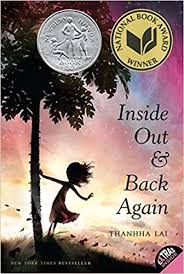Moderated by Lin Oliver, the panelists are Nathan Hale, Kevin Noble Maillard, Elizabeth Rusch, Steve Sheinkin, Melissa Stewart, and Carole Boston Weatherford.
 |
top row, left to right: Lin Oliver and sign language interpreter Brian Truitt
2nd row, left to right: Elisabeth Rusch and Nathan Hale
3rd row, left to right: Kevin Noble Maillard and Carole Boston Weatherford
4th row, left to right: Steve Sheinkin and Melissa Stewart |
Observing that as writers of nonfiction we're "Not just conveyers of information, we’re interpreters of information," Lin introduces the panel. Highlights from the panelists include:
Nathan Hale
Nathan tells us about his Hazardous Tales series, graphic nonfiction. And even his nonfiction cartoon in last Sunday's New York Times Book section.
Using a live sketchbook on screen, Nathan tells us about his process, research to manuscript to images to include in the story.
"I'm constantly looking at pictures so I can have my drawings do the explaining for the readers."
With examples, Nathan tell us that "Cartoons and visuals pack an amazing punch when it comes to nonfiction."
For Hazardous Tales series, Nathan explains how he created narrators, four fictional characters, including one that asks simple questions to help him tell his stories.
"When you pack action and excitement into all this information that's being presented, it removes the barriers to entry" and young readers "jump right in."
Kevin Noble Maillard
Kevin recounts the call telling him his debut Fry Bread had won the ALA's Robert F. Sibert Informational Book Award, and how he learned that it was an informational award - not a nonfiction award. That we can have "books that are nonfiction that are informational, but we can have informational books that might not be nonfictional."
He speaks about layering in art, and in writing. Creating new levels of meaning.
And how he and Fry Bread's illustrator, Juana Martinez-Neal, collaborated to imbue every part of the illustrations with meaning.
Elizabeth Rusch
Elizabeth opens by saying, "One of the reasons I love nonfiction is it is limitless."
She tells us about the Google test - can kids easily type into Google and get the same information you're wanting to portray? If so, you need to dig deeper. "Think about how to offer more."
Elizabeth walks us through, as an exercise, a number of the questions she thinks about when she's interested in writing about a topic.
Can you somehow tell a story with a character, with a narrative arc, what do they want, what obstacles do they face, what's the climax? She tells us about her informative fiction Glacier on the Move book, the story of a Glacier named Flo who wants to visit the sea. Which is what glaciers do! "Think about the narrative arc."
Another question Elizabeth suggests we ask ourselves: "Is there anything new in this area you want to write about?" And then ask yourself, "would kids find this interesting? Do kids need to learn this?"
Steve Sheinkin
Steve talks about writing narrative nonfiction. He recalls another Benedict Arnold book coming out while he was writing The Notorious Benedict Arnold: A True Story of Adventure, Heroism & Treachery and how his editor assured him "You do your book" -- and how that saved him. He wanted to write a page-turning action adventure. A 300 page middle grade nonfiction with no pictures.
"The beautiful thing about nonfiction, the kids that like reading Nathan Hale's books totally like this, too."
On openings, Steve speaks about immediately jumping into the action. "You're going to go through four or five different ones..." Saying eventually, with enough research, maybe towards the end of the writing, "you'll hit on that scene that tells readers what the book is about" and is dynamic.
He starts with writing the exciting things first, and then sprinkles the information (like salt into soup) readers need to know.
If you're not sure if idea is good enough, ask yourself "what's the ending? What's the climax?... If I don't know the ending before I start, I would never start."
Melissa Stewart
Melissa speaks of her expository nonfiction picture books, including her upcoming picture book Summertime Sleepers: Animals That Estivate
Unlike narrative nonfiction which tells a story or experience, expository nonfiction explains something - either a broad overview of a topic, or for narrowly focused books on STEM concepts, like animal adaptations. "It can have pretty much any structure you can think of."
"Instead of reading it from page to page, cover to cover, beginning to end, expository nonfiction can be approached in many ways."
Melissa shares examples from a number of her own works, including Pipsqueaks, Slowpokes, and Stinkers: Celebrating Animal Underdogs.
She points out uses of secondary texts, and text structures like lists, opposites, and the use of onomatopoeia, strong verbs, synonyms, repetition and alliteration, and voice.
Melissa also tells us about big picture revision - "trying to figure out the structure of the book" and then, the word choice, "smaller revisions."
Carole Boston Weatherford
Carole speaks of her book Unspeakable: The Tulsa Race Massacre, sharing that "I borrowed from fairy tales" to give kids something familiar to hang onto, like a security blanket, but also to show that Tulsa, before the massacre, is now vanished history. That was erased by the violence.
She considers how including song titles "creates a built in soundtrack" and that "I fall back on oral traditions quite a bit."
"Sometimes I challenge myself to create in a particular form."
Carole talks about working on multiple books at a time, making lists, and that she now footnotes her sources as she goes. "It's better for me to have the references in the manuscript," as fact-checking sometimes happens a year and a half after writing.
She tries to keep her writing "top of mind," balancing it with her day job.
**
The discussion has the panelists address questions on revision, handling violence in books for young readers, their process, and much more!



















































